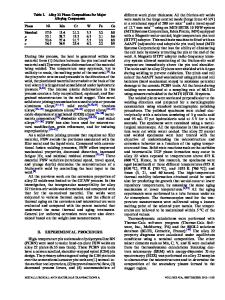Effect of the Solution Annealing and Chemical Passivation Followed by Aging on the Corrosion of Shell Mold Cast CF8 Stai
- PDF / 1,479,281 Bytes
- 4 Pages / 593.972 x 792 pts Page_size
- 19 Downloads / 365 Views
DUCTION
INTERGRANULAR attack in austenitic stainless steels has been of great interests and investigated for about one century.[1] Specifically, intergranular corrosion and sensitization have been focused in relation to chromium depletion at the grain boundaries which is caused by chromium carbide precipitation.[2–8] As austenitic stainless steels are exposed for sufficiently long periods to temperature ranging from [773 K to 1173 K (500 °C to 900 °C)], the precipitation of a large number of phases may occur, such as the d-ferrite, M6C, sigma, chi, and Laves intermetallic phases. The properties and performance of austenitic stainless steels are deeply related to their microstructures, more specifically, the distribution of d-ferrite and its total amount, which, in cases of castings, depend on chemical composition and cooling rate during solidification.[9–13] Among the intermetallic phases that can precipitate in stainless steels, the sigma phase is the most studied. The sigma phase is richer in chromium and molybdenum than the austenite phase and therefore its precipitation at the grain boundaries causes the impoverishment of these elements in the adjacent matrix. However, the precipitation effect on intergranular corrosion resistance in KUK-JIN KIM, Researcher, and SUNG JOON PAK, Senior Researcher, are with HI-STEN Co., Ltd., Gimhae, Korea. Contact email: [email protected] HEONGKYU JU, Professor, is with the Department of Nano-Physics, College of Bionano Technology, Gachon University, Gyeonggi-Do, Korea. YOUNG-DAE MOON, Professor, is with the Division of Mechanical Engineering, Kyungnam University, Changwon, Korea. JUN HO HONG, Chief Researcher, is with KITECH, Incheon, Korea. Manuscript submitted March 22, 2015. METALLURGICAL AND MATERIALS TRANSACTIONS A
stainless steels has not been widely investigated.[14–17] The susceptibility to intergranular corrosion decreases in stainless steels by reducing their carbon content to less than 0.03 wt pct[15] and the main types of this stainless steel class are AISI304L and 316L. Nevertheless, the decrease in carbon content reduces still further the yield strength of the austenite in these steels in an annealed condition. Nitrogen may be added in order to counteract this effect, as is the case with AISI316L(N). Nitrogen in solid solution of the austenite phase increases the strength, stabilizes its phase and increases the pitting resistance.[18–22] We study the effects of precipitation, primarily of d-ferrite phase, on the corrosion resistance of shell mold cast CF8 stainless steel exposed to solution-annealed treatment at 1393 K (1120 °C) and chemical passivation followed by aging periods of up to 2 months. The corrosion resistance of CF8 Elbow pipe fittings can be enhanced by the chemical passivation and the solution-annealed treatment decreases the ferrite phase and permeability improve IGC resistance in CF8 steel. The advantages of using this natural aging indicate the new contributions about corrosion resistance since there are many papers related to chemical passivation and
Data Loading...











